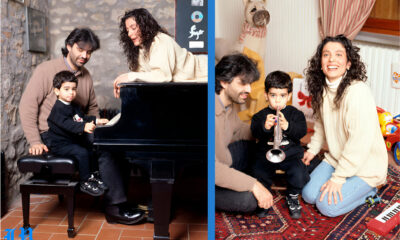LifeStyle
Cat Trees: How to Choose the Perfect Play Structure for Your Feline Friend
Published
10 months agoon
By
Bilal
If you’re a cat owner, you know how much your feline friend loves to climb, scratch, and perch. A cat tree can be the perfect addition to your home, offering your cat a safe and enjoyable space to exercise and relax. But with so many options available, how do you choose the right cat tree for your pet? In this comprehensive guide, we’ll explore everything you need to know about cat trees, from their benefits to the different types available. Whether you’re interested in a flower cat tree, a ball cute cat tree, or something else entirely, we’ve got you covered.
Section 1: What is a Cat Tree?
Understanding Cat Trees
A cat tree, also known as a cat tower or cat condo, is a multi-level structure designed specifically for cats. These structures typically feature platforms, scratching posts, hideaways, and toys that cater to a cat’s natural instincts. Cats are known for their love of climbing, scratching, and finding high vantage points, and a well-designed cat tree provides all of these opportunities in a single piece of furniture.
Benefits of a Cat Tree
Investing in a cat tree offers numerous benefits for both your cat and your home:
- Physical Exercise: Cats need regular physical activity to stay healthy. A cat tree encourages climbing, jumping, and stretching, helping to keep your cat fit and active.
- Mental Stimulation: Cat trees often come with interactive elements like dangling toys and hideaway spots, providing mental stimulation that can prevent boredom.
- Scratching Outlet: Scratching is a natural behavior for cats, but it can be destructive if directed at your furniture. A cat tree with built-in scratching posts gives your cat a designated place to scratch, saving your furniture from damage.
- Personal Space: Cats enjoy having their own space to retreat to. A cat tree offers multiple levels and hideaways where your cat can relax and feel safe.
- Reduction of Territorial Conflicts: In multi-cat households, a cat tree can help reduce territorial disputes by providing each cat with its own space to claim.
Flower Cat Tree
One of the most popular and visually appealing types of cat trees is the flower cat tree. As the name suggests, these cat trees are designed with floral themes, often featuring platforms shaped like flowers, leaves, or petals. Flower cat trees are not only functional but also add a whimsical touch to your home décor. They typically include scratching posts disguised as tree trunks and soft, cushioned flower-shaped perches where your cat can rest.
- Perfect for Aesthetic Lovers: The flower cat tree is ideal for cat owners who want their pet’s furniture to blend seamlessly with their home’s interior design. It’s a great way to add a pop of color and creativity to your living space while providing a fun and comfortable environment for your cat.
- Variety of Sizes: Flower cat trees come in various sizes, from compact models that fit into small spaces to larger structures that offer multiple levels for climbing and exploring.
Ball Cute Cat Tree
The ball cute cat tree is another delightful option that combines playfulness with functionality. These cat trees feature rounded, ball-shaped platforms or hideaways that add an element of fun to your cat’s playtime. The spherical design often includes soft padding and cozy interiors where your cat can curl up and nap.
- Interactive Play: Ball cute cat trees often come with attached toys like feathers or bells that encourage your cat to play and engage with the structure. This keeps your cat entertained and mentally stimulated.
- Space-Efficient: Many ball cute cat trees are designed to be compact, making them a great choice for smaller homes or apartments where space is limited.
Cute Cat Tree
The term “cute cat tree” can refer to any cat tree that is designed with aesthetics in mind, often featuring playful shapes, bright colors, and charming details. These cat trees are perfect for cat owners who want their pet’s furniture to be as stylish as it is functional.
- Customization Options: Many manufacturers offer customization options for cute cat trees, allowing you to choose colors, patterns, and accessories that match your home’s décor.
- Versatility: Cute cat trees come in various designs, from minimalistic and modern to elaborate and themed. Whether you want a sleek, understated look or a playful and colorful design, there’s a cute cat tree to suit your taste.
Consider Your Cat’s Personality
When selecting a cat tree, it’s essential to consider your cat’s personality and preferences. Here are a few factors to keep in mind:
- Activity Level: If your cat is highly active and loves to climb and jump, opt for a tall cat tree with multiple levels and platforms. For a more laid-back cat, a shorter, simpler cat tree with comfortable perches may be sufficient.
- Age and Mobility: Older cats or those with mobility issues may benefit from a cat tree with ramps or lower platforms, making it easier for them to access.
- Social Behavior: In multi-cat households, choose a cat tree with enough space for all your cats to enjoy without feeling crowded. Look for models with multiple perches, hideaways, and scratching posts to accommodate each cat’s needs.
Assess Your Space
Before purchasing a cat tree, evaluate the available space in your home:
- Location: Decide where you want to place the cat tree. Common locations include living rooms, bedrooms, and near windows, where cats can enjoy an outside view. Ensure the spot you choose has enough room for the cat tree without obstructing foot traffic.
- Size and Height: Measure the space where you plan to place the cat tree to ensure it will fit comfortably. Consider the height of the cat tree as well; taller models may require higher ceilings and more floor space.
Material and Durability
The material of the cat tree plays a crucial role in its durability and comfort:
- Carpet: Many cat trees are covered in carpet, providing a soft surface for your cat to scratch and rest on. However, carpeted cat trees may wear out over time and require replacement.
- Sisal Rope: Sisal rope is a popular material for scratching posts, as it’s durable and satisfies your cat’s natural urge to scratch. Look for cat trees with sisal-covered posts to prevent damage to your furniture.
- Wood: Some cat trees are made from wood, offering a sturdy and long-lasting structure. Wooden cat trees often have a more natural look and may be easier to clean than carpeted models.
Safety Considerations
Safety is paramount when choosing a cat tree:
- Stability: Ensure the cat tree is stable and won’t tip over when your cat jumps on or off it. Look for models with a wide base and secure attachments.
- Non-Toxic Materials: Verify that the materials used in the cat tree are non-toxic and safe for your cat. Avoid cat trees with loose parts or small pieces that could pose a choking hazard.
Section 4: Tips for Setting Up Your Cat Tree
Location is Key
Place the cat tree in a location where your cat spends a lot of time. Cats love to observe their surroundings, so positioning the cat tree near a window can provide hours of entertainment as they watch birds, squirrels, and other outdoor activities.
Introduce Your Cat to the New Tree
Cats can be wary of new objects in their environment, so it’s important to introduce the cat tree gradually. Place your cat’s favorite toys or treats on the tree to encourage exploration. You can also sprinkle a little catnip on the tree to make it more enticing.
Maintenance and Cleaning
Regularly clean the cat tree to keep it in good condition and ensure your cat’s health. Vacuum the carpeted areas to remove fur and dirt, and wipe down any wood or plastic parts with a damp cloth. Check for signs of wear and tear, and replace any worn-out components to maintain the tree’s safety and stability.
Encourage Playtime
Use the cat tree as a central part of your cat’s playtime routine. Dangle toys from the platforms, hide treats in the hideaways, and encourage your cat to climb and explore. Engaging with your cat on the tree will help them feel more comfortable and make the most of their new play structure.
Section 5: Frequently Asked Questions (FAQs)
1. How do I choose the right size cat trees for my cat?
Consider your cat’s size, age, and activity level when choosing a cat trees. Larger cats may require a more robust and taller cat trees with wide platforms, while smaller or older cats may be more comfortable with a shorter tree.
2. Can I use a cat trees for multiple cats?
Yes, cat trees are great for multi-cat households. Choose a model with multiple levels, platforms, and hideaways to provide enough space for all your cats to enjoy.
3. How do I clean a cat trees?
Regularly vacuum carpeted areas to remove fur and dirt. For wood or plastic parts, wipe them down with a damp cloth. Check for any worn-out parts and replace them as needed to maintain the cat tree’s safety and appearance.
4. Are there cat trees for small spaces?
Yes, many cat trees are designed to fit into small spaces. Look for compact models or corner cat trees that maximize vertical space without taking up too much floor area.
5. Can I customize my cat tree?
Many manufacturers offer customization options, allowing you to choose the colors, patterns, and accessories that best suit your home’s décor and your cat’s preferences.
Conclusion
A cat trees is more than just a piece of furniture; it’s an essential part of your cat’s life, providing exercise, entertainment, and comfort. Whether you opt for a flower cat tree, a ball cute cat trees, or a traditional model. Choosing the right cat tree for your feline friend can enhance their well-being and bring joy to your home. By considering your cat’s personality, the available space, and the materials used, you can find the perfect cat trees that both you and your cat will love. So, why wait? Start shopping for the ideal cat trees today and watch your furry friend enjoy their new playground

Who Is Lynn Hamilton? Celebrating the Life and Legacy of the American Actress

Who is Mickey Gooch Jr? The Dynamic Journey of a Film Producer and Actor

Who Is Pierre Bouvier? All About the Canadian Singer and Musician Behind Simple Plan

Who Is Pearl Minnie Anderson? Rising Star in Maya Rudolph’s Legacy

Who is Minnie Pearl? The American Comedian Who Brought Country Humor to the Spotlight

Who Is Kavan Smith? The Canadian Actor Known for His Versatile Roles

Who is Olivia Rose Cameron: The Creative Artist & Daughter of Kirk Cameron

Who Is Markella Kavenagh? All About the Australian Actress and Rising Star

Who is Tracey Hinds? Exploring the Life of Macy Gray’s Ex-Husband and Mortgage Broker

Who is Eric Weinberger? A Visionary Television Producer Shaping Sports Media

Who Is Dan Jeannotte? All About the Canadian Actor’s Career and Roles

Who Is Paul Fenech? Inside the World of the Australian Filmmaker and Actor

Who Is Merri Kelly Hannity? All About Sean Hannity’s Daughter

Who Is Diana Espinoza Aguilar? The Story of Rafael Caro Quintero’s Wife

Who is Charlee Fraser? The Rise of the Australian Model and Actress Making Global Waves

Who Is James Lesure? All About the American Film and Television Actor

Who Is Toru Ohtani? All About Shohei Ohtani’s Father & Baseball Coach

Who is Eric Weinberger? A Visionary Television Producer Shaping Sports Media

Who is Torrei Hart? The Multitalented Actress and Comedian Making Waves

Who Is Avantika Vandanapu? Rising American Actress & Singer

Who Is Lynn Hamilton? Celebrating the Life and Legacy of the American Actress

Who is Mickey Gooch Jr? The Dynamic Journey of a Film Producer and Actor

Who Is Pierre Bouvier? All About the Canadian Singer and Musician Behind Simple Plan

Who Is Pearl Minnie Anderson? Rising Star in Maya Rudolph’s Legacy

Who is Minnie Pearl? The American Comedian Who Brought Country Humor to the Spotlight

Who Is Kavan Smith? The Canadian Actor Known for His Versatile Roles

Who is Olivia Rose Cameron: The Creative Artist & Daughter of Kirk Cameron

Who Is Markella Kavenagh? All About the Australian Actress and Rising Star

Who is Tracey Hinds? Exploring the Life of Macy Gray’s Ex-Husband and Mortgage Broker

Who is Eric Weinberger? A Visionary Television Producer Shaping Sports Media
Trending
-

 Celebrity11 months ago
Celebrity11 months agoNecati Arabacı: Net Worth, Biography, and More
-

 Celebrity12 months ago
Celebrity12 months agoDiscovering Lily Phillips: An Insight into Her Life and Career
-

 Celebrity12 months ago
Celebrity12 months agoParker Schnabel’s Girlfriend: A Comprehensive Look at His Relationships Over the Years
-

 Celebrity11 months ago
Celebrity11 months agoEnrica Cenzatti: Life of Andrea Bocelli’s Ex-Wife
